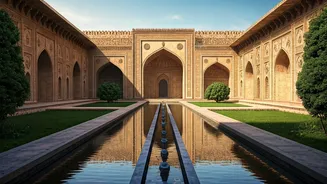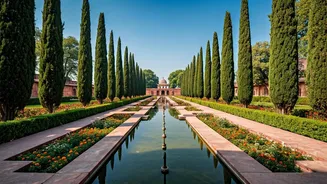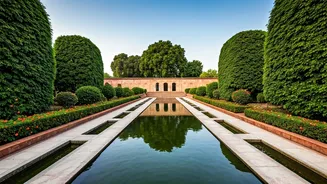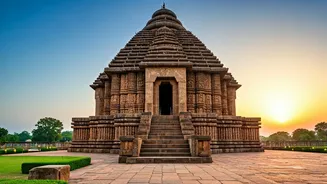Introduction to Mughal Gardens
Mughal Gardens, a distinctive blend of Persian and Indian architectural styles, showcase a unique approach to garden design. These gardens, introduced
during the Mughal Empire, are characterized by their formal layouts, symmetrical designs, and meticulous water features like canals, pools, and fountains. The aesthetic is strongly influenced by the concept of paradise gardens, aiming to create a serene and visually pleasing environment. Beyond their aesthetic appeal, Mughal Gardens served as spaces for relaxation, social gatherings, and displays of imperial power and wealth. They also represent a significant contribution to the cultural heritage of India, integrating art, nature, and architecture into a cohesive experience. These gardens stand as testaments to the Mughal emperors' appreciation for beauty, detail, and their ability to blend different cultural influences into a unique and enduring art form.
Shalimar Bagh, Srinagar
Shalimar Bagh, located in Srinagar, Jammu, and Kashmir, is a premier example of Mughal garden artistry. Built by Emperor Jahangir for his wife Nur Jahan in 1619, the garden spreads across terraces that descend from a higher level, providing picturesque views of the Dal Lake. The design features a central water channel, fountains, and carefully arranged flowerbeds, reflecting a paradise-like setting. Its layout is symmetrical, embodying the core elements of Mughal garden design. The garden's serene atmosphere provides a perfect spot for both recreation and contemplation. Over the years, Shalimar Bagh has become a major tourist spot, providing a glimpse into the glorious past of Mughal India and the enduring legacy of Jahangir and Nur Jahan's love story.
Nishat Bagh, Srinagar
Nishat Bagh, or 'Garden of Bliss', is situated on the eastern side of Dal Lake in Srinagar, Jammu, and Kashmir. Designed by Asaf Khan, Nur Jahan's brother, the garden's layout emphasizes a cascading design with multiple terraces that overlook the lake. The garden's layout is symmetrical. The terraced design allows for stunning views as visitors move upwards through the levels. This garden is a testament to the Mughal fascination with combining art, beauty, and nature. Nishat Bagh is designed to create a sense of harmony and tranquility. It provides an excellent example of how Mughal gardens utilized the natural landscape to enhance their visual appeal, establishing themselves as prominent examples of art and design.
Yusuf Bagh, Srinagar
Yusuf Bagh, another gem in Srinagar, Jammu, and Kashmir, is attributed to the Mughal era, although its precise origins are somewhat shrouded in history. The garden is characterized by its orderly design, with carefully structured pathways and planted areas which create a pleasing and calming environment. This garden exemplifies the core principles of Mughal garden architecture, highlighting symmetry, water features, and the integration of the garden into its natural setting. While less celebrated than some of its counterparts, Yusuf Bagh shows the refined art of the Mughal period. The garden provides insight into the era's sophisticated gardening practices, which aimed at crafting spaces of peace and aesthetic pleasure.
Humayun's Tomb Garden, Delhi
The garden surrounding Humayun's Tomb in Delhi, built in the 16th century, represents a significant development in Mughal garden design. This garden, which is a UNESCO World Heritage site, is known for its charbagh layout, divided into four main quadrants, with pathways and water channels that create a symmetric design. The tomb is positioned at the center, symbolizing the importance of the emperor and his place in the garden's design. The garden incorporates elements such as water features, pathways, and green spaces to create a paradise-like setting, reflecting the beliefs and values of the Mughal Empire. Humayun's Tomb Garden is a key example of how Mughal architecture combined the environment with art and spirituality, offering a peaceful and beautiful experience.
Taj Mahal Garden, Agra
The Taj Mahal Garden in Agra is recognized worldwide as a masterpiece of Mughal architecture. Constructed in the 17th century, the garden represents the pinnacle of Mughal garden design. The garden's symmetrical layout, with its charbagh style, is carefully organized around the mausoleum. Water channels reflect the Taj Mahal and add beauty and depth, and the pathways create a harmonious flow. The garden’s design symbolizes the paradise described in Islamic beliefs, featuring lush green areas and beautiful flowers. It perfectly represents the union of art, design, and spirituality. The Taj Mahal Garden's integration with the architecture of the Taj Mahal is a tribute to Emperor Shah Jahan's love for his wife, Mumtaz Mahal.
Mehtab Bagh, Agra
Mehtab Bagh, situated across the Yamuna River from the Taj Mahal in Agra, presents a different perspective on Mughal garden design. Initially built as a moonlit garden in the 17th century, it was designed to provide a serene view of the Taj Mahal under the moonlight. The garden features a symmetrical layout with pools and pathways designed to reflect the Taj Mahal, amplifying its beauty. Despite facing damage over time, the garden has been renovated, which allows visitors to enjoy stunning views of the Taj Mahal. Mehtab Bagh exemplifies how Mughal gardens were often intricately designed to offer specific visual experiences, capturing the harmony between nature and architectural beauty.
Pinjore Garden, Haryana
Pinjore Garden, also known as Yadavindra Garden, is located in the Panchkula district of Haryana. This garden is a prime example of Mughal garden architecture in Northern India. Built during the 17th century, the garden's tiered layout is meticulously planned, with fountains, water channels, and pavilions at various levels, creating a sense of visual depth and movement. Its design integrates the natural topography, and the garden incorporates various architectural elements that reflect Mughal aesthetic principles. Pinjore Garden shows the widespread influence of Mughal garden design across the Indian subcontinent and serves as a significant spot for visitors to admire the detailed design that celebrates the Mughals' sophisticated understanding of art and nature.
Rambagh Garden, Agra
Rambagh Garden, believed to be the oldest Mughal garden in India, is situated in Agra. Built in 1528, this garden marks an early stage in the development of Mughal garden designs. Its layout includes formal arrangements of flowerbeds, pathways, and water channels. The garden highlights the Mughals' focus on symmetry and creating a tranquil environment. The historical importance of Rambagh Garden is significant, as it provides an insight into how Mughal garden design evolved over time. Despite its age, the garden still reflects the fundamental elements of Mughal design, demonstrating a commitment to creating beautiful and calm spaces.
Khusro Bagh, Prayagraj
Khusro Bagh in Prayagraj showcases the fusion of Mughal and Indian architectural styles. This garden is centered around the tombs of Khusrau Mirza, the eldest son of Emperor Jahangir, and his family. The garden's layout incorporates elements of Persian design, such as water channels and symmetrical pathways, while also reflecting indigenous architectural features. The tombs are adorned with intricate carvings and embellishments, representing the integration of art and faith. Khusro Bagh reflects the Mughal Empire's ability to blend different cultural and artistic traditions. It stands as a testament to the Mughal legacy and offers an opportunity to experience their rich aesthetic values, which promoted harmony.














